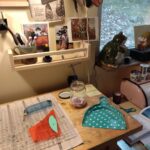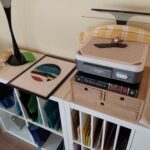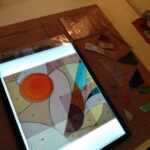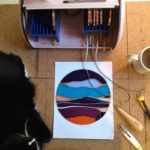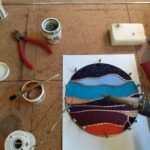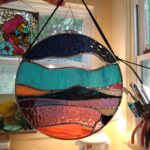Featured Artist: Tere Mullin
01 Nov 2024
Throughout human history, nature has been a profound source of artistic inspiration. In this series, we talk with artists whose work is inspired by, created in, or connected to the brilliant nature in the Nature Trust’s care.
 Tere Mullin has worked in stained glass for just over a year. After having tried several different art forms over the years, glass has quickly become her passion. She explains that “Working in stained glass is a little bit like piecing together a puzzle, and a little bit like alchemy. Glass is more flexible than one might imagine, but it does have a mind of its own; no matter how much I plan a piece, I always get a little thrill when the process is complete and I see it with the sun shining through it.”
Tere Mullin has worked in stained glass for just over a year. After having tried several different art forms over the years, glass has quickly become her passion. She explains that “Working in stained glass is a little bit like piecing together a puzzle, and a little bit like alchemy. Glass is more flexible than one might imagine, but it does have a mind of its own; no matter how much I plan a piece, I always get a little thrill when the process is complete and I see it with the sun shining through it.”
Much of her work is inspired by the natural environment where she lives with her husband and three cats, in Aspotogan, Nova Scotia.
Are there specific aspects of the natural world in Nova Scotia that drew you toward choosing stained glass as your medium to create artwork?
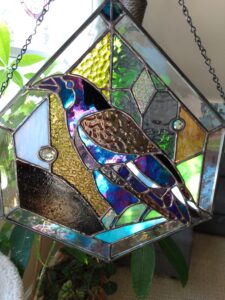
I came to stained glass as a medium in a somewhat circuitous way. I have always been a maker in one way or another, and I’ve loved art since I was a child. Over the years I’ve dabbled in many art forms and crafts—everything from knitting, to pottery, to origami—and nature and animals have always been a favourite subject.
For some reason, I always thought of myself as a painter. I focused on painting while at the Nova Scotia College of Art & Design (NSCAD), and over the years I considered it my main focus. The funny thing is, I never really enjoyed it. I felt driven to express myself through painting, and very much wanted to improve, but the process was always a struggle. Then in the spring of 2023, I developed a health issue that affected my hands and made repetitive movements (such as holding a paint brush for long periods) difficult. So I put painting aside and decided to try something new. I had always wanted to try making stained glass art, and after watching a few videos online, I saw that although dexterity was needed, the process involves many different steps, rather than anything repetitive. Over time I’ve found ways to make the process a bit easier, such as relying on tools whenever possible. I’m thankful for that little push from the universe, because I feel I’ve finally found my calling!
Your work seems to invite the viewer to look at nature with colours and shapes that evoke a feeling rather than a literal interpretation of an animal or landscape, and despite being made from hard materials like glass and metal, they provoke a wonderful sense of flow and movement. How do you approach choosing colour and shape when composing your images?
 One of the things I love most about working with glass is its limitations. Although glass is surprisingly strong, there are only certain ways it can be cut. This provides parameters with respect to the composition. I find this challenge exciting because it means there is a limit to how much I can impose on the glass, and there is always an element of mystery as far as how the finished piece will look. To a certain extent, the glass dictates the direction of the piece.
One of the things I love most about working with glass is its limitations. Although glass is surprisingly strong, there are only certain ways it can be cut. This provides parameters with respect to the composition. I find this challenge exciting because it means there is a limit to how much I can impose on the glass, and there is always an element of mystery as far as how the finished piece will look. To a certain extent, the glass dictates the direction of the piece.
I begin with a drawing, and then look at my materials to see how they might work with this idea and with the mood I want to capture. I take inspiration from the glass and how different colours and textures look together. I allow it to lead as far as colour. I might have a general idea of a colour scheme, and then end up working around one particular combination of pieces that really speaks to me.
I also take inspiration from other art forms such as painting and printmaking. I’m not a fan of hyperrealism; to me, the beauty of art is in the artist’s interpretation of the subject, and I like to leave room for interpretation on the part of the viewer as well. I’ve always loved impressionistic art for this reason.
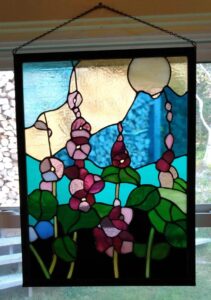
Has there been a particular landscape or experience in nature that profoundly influenced one of your pieces?
To me there is nothing more captivating than the forest and the animals that live there, and I’ve always felt at home in the woods. My husband and I moved to the South Shore in 2019, and the fogginess of the area, the granite moss-covered boulders and the coastline are so evocative to me. Our property is heavily wooded, and I enjoy exploring on daily walks. Each day the woods feel a little different. The atmosphere changes depending on the time of day and the light, on the kind of cloud cover, on the smells and sounds (sometimes one can even hear seals howling in the distance). It’s these nuances that really inspire me.
Do you see your artwork as connecting with broader environmental or ecological themes, or do you focus on personal expression when making your creations?
For me, stained glass is another way of experiencing and appreciating nature. I don’t create with the intention of affecting viewers in a particular way, but if my work leads others to notice the beauty and value of nature, I couldn’t ask for anything more.
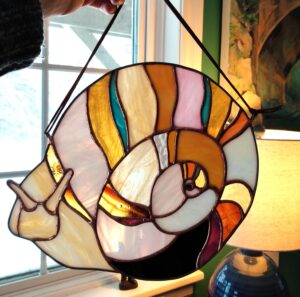 Something I’m navigating is the environmental impact of the materials I use as a stained glass artist. There are consumables and a certain amount of waste involved, and the glass-making process itself has ecological impacts. I’m always trying different ways of doing things to reduce waste, and I do save and use scraps as much as possible. Some time ago I began cutting my patterns into adhesive vinyl, which I then stick to the glass as a template to cut around. Unfortunately, while this method allows me to be much more accurate in my glass cutting, I am producing PVC vinyl waste. I realize that comparatively, I’m not a huge contributor to the plastic waste issue, but it still weighs on me that I’m part of the problem. I’m still in the process of trying to determine if there is a way to recycle this material, and trying to source PVC-free vinyl in Canada. I also only use this method for more complex pieces and use reusable cardboard patterns for the majority of my work.
Something I’m navigating is the environmental impact of the materials I use as a stained glass artist. There are consumables and a certain amount of waste involved, and the glass-making process itself has ecological impacts. I’m always trying different ways of doing things to reduce waste, and I do save and use scraps as much as possible. Some time ago I began cutting my patterns into adhesive vinyl, which I then stick to the glass as a template to cut around. Unfortunately, while this method allows me to be much more accurate in my glass cutting, I am producing PVC vinyl waste. I realize that comparatively, I’m not a huge contributor to the plastic waste issue, but it still weighs on me that I’m part of the problem. I’m still in the process of trying to determine if there is a way to recycle this material, and trying to source PVC-free vinyl in Canada. I also only use this method for more complex pieces and use reusable cardboard patterns for the majority of my work.
How does the stained glass process actually work?
I begin each stained glass piece with a finalized drawing, which I make a copy of. I often do this by hand, but if I think I may make several of a piece, I digitize the drawing using computer software. One copy of the pattern gets cut into pieces to use as a template for glass-cutting, and the other is used for reference while I’m working.
Click on the images below to see the rest of the process, described by Tere step-by-step in the captions.
Has your relationship with nature evolved through your art process?
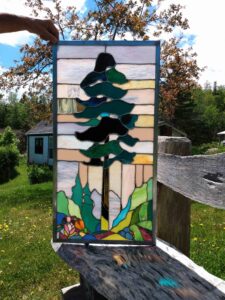 Like many people who are concerned about the natural world, my relationship to it is often bittersweet. I struggle with finding a balance between being aware of what’s happening and remaining positive. Habitat loss, anthropocentrism, the destruction caused by natural disasters—it’s overwhelming and heartbreaking. Paradoxically, I find myself at a place where direct involvement in climate action is more than I can handle, and yet I want to help. Recently, I’ve been considering how I could donate my work to help raise funds for organizations such as the Nova Scotia Nature Trust. In a way, stained glass may have opened a door for me to participate in conservation and environmental protection in my own way. I hope to also help support animal shelters through donations of my work as well. I’m optimistic that this could be an indirect way of doing my part, however small.
Like many people who are concerned about the natural world, my relationship to it is often bittersweet. I struggle with finding a balance between being aware of what’s happening and remaining positive. Habitat loss, anthropocentrism, the destruction caused by natural disasters—it’s overwhelming and heartbreaking. Paradoxically, I find myself at a place where direct involvement in climate action is more than I can handle, and yet I want to help. Recently, I’ve been considering how I could donate my work to help raise funds for organizations such as the Nova Scotia Nature Trust. In a way, stained glass may have opened a door for me to participate in conservation and environmental protection in my own way. I hope to also help support animal shelters through donations of my work as well. I’m optimistic that this could be an indirect way of doing my part, however small.
Thank you to Tere for sharing her perspective on art and nature!
If you are an artist and would like to share the story of how nature influences your art, please reach out to us at nature@nsnt.ca!

